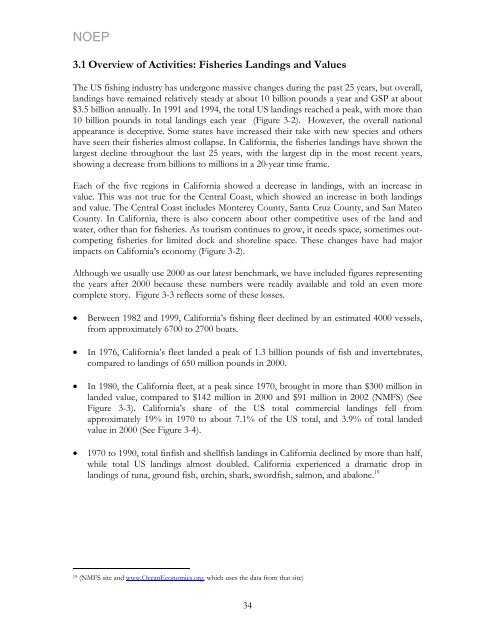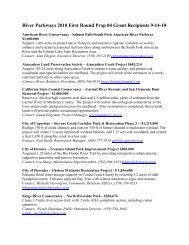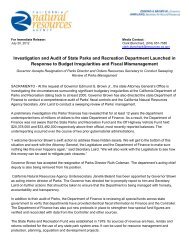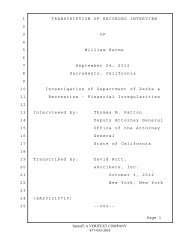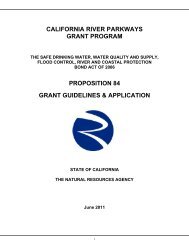California's Ocean Economy - California Resources Agency - State ...
California's Ocean Economy - California Resources Agency - State ...
California's Ocean Economy - California Resources Agency - State ...
You also want an ePaper? Increase the reach of your titles
YUMPU automatically turns print PDFs into web optimized ePapers that Google loves.
NOEP<br />
3.1 Overview of Activities: Fisheries Landings and Values<br />
The US fishing industry has undergone massive changes during the past 25 years, but overall,<br />
landings have remained relatively steady at about 10 billion pounds a year and GSP at about<br />
$3.5 billion annually. In 1991 and 1994, the total US landings reached a peak, with more than<br />
10 billion pounds in total landings each year (Figure 3-2). However, the overall national<br />
appearance is deceptive. Some states have increased their take with new species and others<br />
have seen their fisheries almost collapse. In <strong>California</strong>, the fisheries landings have shown the<br />
largest decline throughout the last 25 years, with the largest dip in the most recent years,<br />
showing a decrease from billions to millions in a 20-year time frame.<br />
Each of the five regions in <strong>California</strong> showed a decrease in landings, with an increase in<br />
value. This was not true for the Central Coast, which showed an increase in both landings<br />
and value. The Central Coast includes Monterey County, Santa Cruz County, and San Mateo<br />
County. In <strong>California</strong>, there is also concern about other competitive uses of the land and<br />
water, other than for fisheries. As tourism continues to grow, it needs space, sometimes outcompeting<br />
fisheries for limited dock and shoreline space. These changes have had major<br />
impacts on <strong>California</strong>’s economy (Figure 3-2).<br />
Although we usually use 2000 as our latest benchmark, we have included figures representing<br />
the years after 2000 because these numbers were readily available and told an even more<br />
complete story. Figure 3-3 reflects some of these losses.<br />
• Between 1982 and 1999, <strong>California</strong>’s fishing fleet declined by an estimated 4000 vessels,<br />
from approximately 6700 to 2700 boats.<br />
• In 1976, <strong>California</strong>’s fleet landed a peak of 1.3 billion pounds of fish and invertebrates,<br />
compared to landings of 650 million pounds in 2000.<br />
• In 1980, the <strong>California</strong> fleet, at a peak since 1970, brought in more than $300 million in<br />
landed value, compared to $142 million in 2000 and $91 million in 2002 (NMFS) (See<br />
Figure 3-3). <strong>California</strong>’s share of the US total commercial landings fell from<br />
approximately 19% in 1970 to about 7.1% of the US total, and 3.9% of total landed<br />
value in 2000 (See Figure 3-4).<br />
• 1970 to 1990, total finfish and shellfish landings in <strong>California</strong> declined by more than half,<br />
while total US landings almost doubled. <strong>California</strong> experienced a dramatic drop in<br />
landings of tuna, ground fish, urchin, shark, swordfish, salmon, and abalone. 19<br />
19 (NMFS site and www.<strong>Ocean</strong>Economics.org, which uses the data from that site)<br />
34


